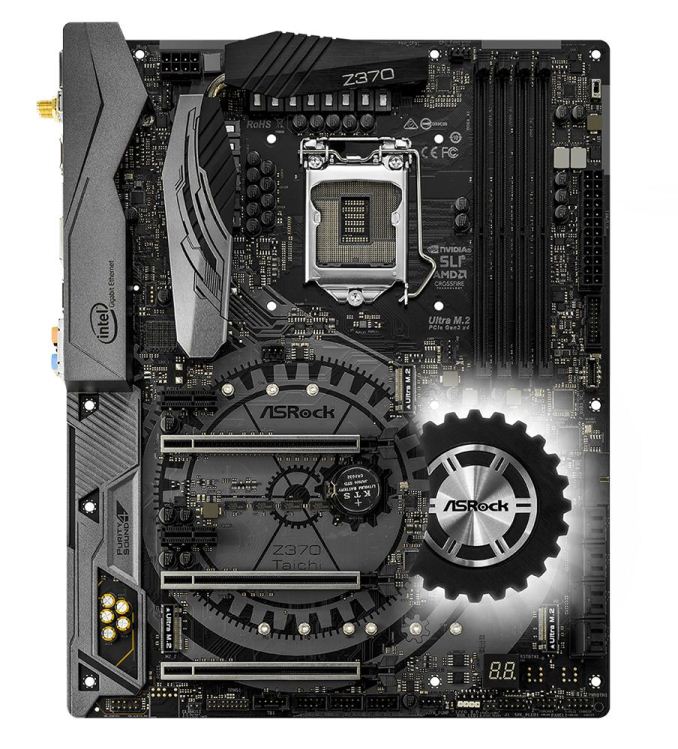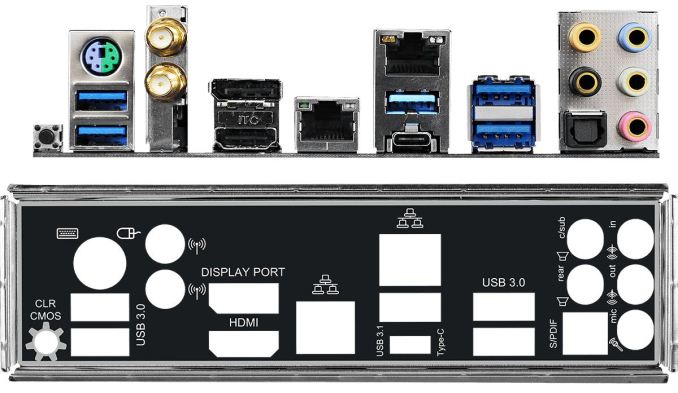Analyzing Z370 for Intel's 8th Generation Coffee Lake: A Quick Look at 50+ Motherboards
by Ian Cutress, Anton Shilov, Joe Shields & Gavin Bonshor on October 20, 2017 2:00 PM ESTASRock Z370 Taichi
In a board that stands in the ASRock's 'upper mid-range' class on its own, the Taichi name lives on another generation in the Z370 Taichi. As with those that came before it, Taichi boards are aimed to be balanced, and do not show a propensity to lean in any which way: gaming, workstation, overclocking, it could (like many other motherboards) do it all. The Z370 version won’t stray from that target either.
The Z370 Taichi looks almost the same as its bigger brother on the X299 platform. The same cog or gear artwork is featured prominently in grey against the all black PCB. The back panel and audio section are covered with the same style shroud from the X299 Taichi. The large VRM heatsinks from the Gaming i7 and Gaming K6 also find their way to the Taichi but in black instead of grey. The chipset heatsink, also in the shape of a gear, is the only place on the board to find RGB LEDs. Users are able to add more color via an LED strip through the onboard header.
The four memory slots provide support for 64GB, with speeds up to DDR4-4333. The Taichi has three reinforced full-length GPU slots, capable of x16 in single card, x8/x8 with two cards, and x8/x4/x4 in three card mode, meaning the board supports both 2-way SLI and 3-way Crossfire. There are also two open-ended PCIe x1 slots, powered from the chipset.
The board offers six SATA ports from the chipset, two SATA ports from an additional controller, and three M.2 slots. The bottom two M.2 devices support up to 110mm while the top supports up to 80mm. The slots do share lanes, so that if the first M.2 slot is populated, SATA 0/1 are disabled. If the second M.2 slot is in use, SATA 4/5 are disabled. Last, if the third M.2 slot is populated by a SATA type M.2 device, SATA3 is disabled, so be aware.
The board has five 4-pin fan headers in various locations around the board to allow for BIOS or F-Stream software control in Windows. The CPU Optional and Chassis Optional pumps both deliver 1.5A/18W to the headers, for powering pumps from AIOs or custom built loops. The same audio found on the higher end boards also made it over to the Taichi via the Realtek ALC1220 codec, and uses Nichicon Gold series audio caps as well as a Texas Instruments NE5532 headset amplifier. Two Intel Ethernet controllers, the Intel I219-V and Intel I211-AT, and an Intel W-Fi module, make up the network side. As with nearly all the ASRock boards, Thunderbolt support is handled by a 5-pin add-in-card connector.
USB connectivity on the back panel IO consists of a USB 3.1 (10 Gbps) Type-A port and Type-C port from an ASMedia ASM3142, as well as four USB 3.1 (5 Gbps) ports from the chipset. A front panel USB 3.1 (10 Gbps) header is found internally, along with three USB 2.0 headers (chipset) and two more USB 3.1 (5 Gbps) headers (ASM1074 hub). The remainder of the back panel IO contains a Clear CMOS button, a combination PS/2 port, DisplayPort and HDMI, and audio jacks plus SPDIF.













83 Comments
View All Comments
Hxx - Monday, October 23, 2017 - link
no they're not. the gigabyte gaming 5 is $200 the gaming 7 is $250 (just so happen I was looking at some gigabyte boards). Those prices are as high as z270 when it came out. In comparison, you could get a z270 gaming 7 for like 150. That's just one example I'm sure there are others. There is definitely a premium built into these boards for something that is nothing more than a stop gap and that will become obsolete 6 months from now.Hixbot - Sunday, October 22, 2017 - link
Only one board with 10GBE? That's dissapointing.pvdw - Sunday, October 22, 2017 - link
I'd really like reviews of the mITX boards, particularly the ASRock Z370 Gaming-ITX/ac. I'll be building a portable gaming + workstation to go in this case when it comes in January: https://www.kickstarter.com/projects/33753221/dan-...Thanks!
pvdw - Sunday, October 22, 2017 - link
mITX -> ITXTwister292 - Sunday, October 22, 2017 - link
The Aorus Gaming 5's M.2 slots are actually 2x110mm and 1x80mm accoding to the manual. It's also visible...the M2 slot at the top and the middle slot have 4 positions for the screws, the bottom slot has only 3.takeshi7 - Monday, October 23, 2017 - link
Asus, stop putting electrolytic capacitors on your TUF boards. The main reason I buy TUF boards is for the all solid caps. I don't care about "Nichicon gold" audio caps, and anyone who's serious about audio will have an external DAC or another sound card anyways. STAHHHP!Samus - Monday, October 23, 2017 - link
Having a "quick look" at 50 motherboards is somewhat an oxymoron, isn't it?tezpez - Tuesday, October 24, 2017 - link
May have spotted an error in the article - Asus Strix 370-F doesn't have wifi, whereas this page says it does: https://www.anandtech.com/show/11860/z370-motherbo...number58 - Tuesday, October 24, 2017 - link
The pictures for the Gigabyte Z370 Gaming K3 are actually some MSI mini itx board.pjcamp - Tuesday, October 24, 2017 - link
No, question 1 is "do I give 2 sh!ts about gaming?" How about a little help for people who are NOT twitch fanatics?